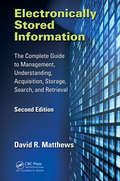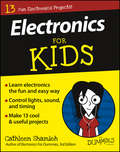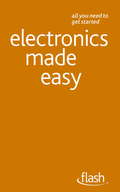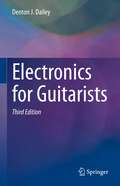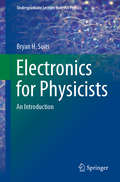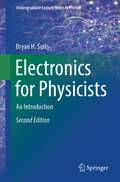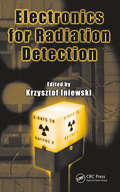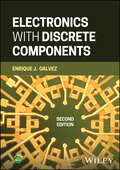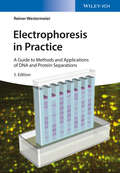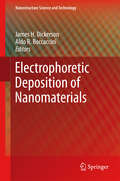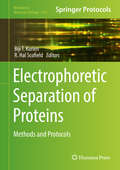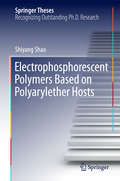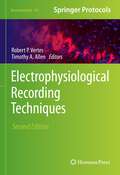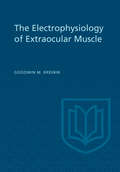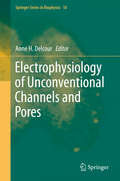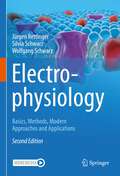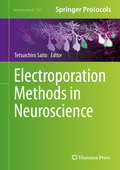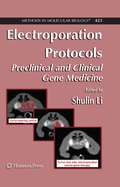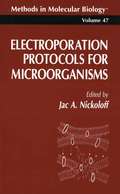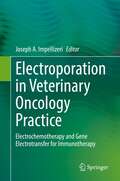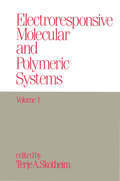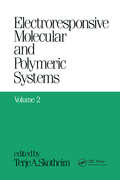- Table View
- List View
Electronically Stored Information: The Complete Guide to Management, Understanding, Acquisition, Storage, Search, and Retrieval
by David MatthewsAlthough we live in an era in which we are surrounded by an ever-deepening fog of data, few of us truly understand how the data are created, where data are stored, or how to retrieve or destroy data—if that is indeed possible. This book is for all of you, whatever your need or interest. <p><P>Electronically Stored Information: The Complete Guide to Management, Understanding, Acquisition, Storage, Search, and Retrieval, Second Edition explains the reasons you need to know about electronic data. It also gets into great detail about the how, what, when, and where of what is known in legal circles as electronically stored information (ESI). <p><P>With easy-to-understand explanations and guidelines, this book provides the practical understanding you need to effectively manage the complex world of ESI. Whether you are an attorney, judge, paralegal, business manager or owner, or just one of the ever-growing population of computer users, you will benefit from the information presented in this book.
Electronics For Kids For Dummies
by Cathleen ShamiehThe easy way for kids to get started with electronics If your youngster likes to tinker, Electronics For Kids For Dummies is here to teach them the core concepts of electronics in a fun and engaging way. Written in a language elementary-to-middle-school-aged kids can understand, it's packed with full-color photos, easy-to-follow instructions, simple examples, and 13 cool projects that will boost your child's confidence while instilling valuable electronics lessons. Written by an experienced engineer who authored Electronics For Dummies, this friendly guide shows children the right way to learn about this exciting--but potentially dangerous--field. From making their very own LED flashlight and basic radio to building a smart nightlight and making an LED blink, Electronics For Kids For Dummies walks young readers through 13 projects that are easy to accomplish--and, most importantly, fun! Plus, the full-color design is heavy on eye-catching graphics and the format is focused on the steps to completing a project, making it approachable for any youngster with an interest in exploring the electrifying world of electronics. Introduces kids to the basics of electronics Includes 13 projects that promote your kid's sense of achievement Features larger print to make the material less intimidating and easier to navigate Covers tools and safety measures to ensure your child's safety Spark your child's interest in the shockingly exciting field of electronics with Electronics For Kids For Dummies!
Electronics Made Easy: Flash
by Malcolm PlantThis new title in the popular 'Flash' series gets straight to the key facts of electronics. In just 96 pacy, jargon-free pages, you will:- get to grips with circuits- understand Ohm's Law- use capacitors and resistors- explore truth tables- examine control systemsand much more besides!
Electronics Made Easy: Flash
by Malcolm PlantThis new title in the popular 'Flash' series gets straight to the key facts of electronics. In just 96 pacy, jargon-free pages, you will:- get to grips with circuits- understand Ohm's Law- use capacitors and resistors- explore truth tables- examine control systemsand much more besides!
Electronics for Guitarists
by Denton J. DaileyThis updated, augmented third edition is aimed at hobbyists, students, engineers, and others who would like to learn more about the design and operation of electronic circuits used by guitarists. This book presents accessible qualitative and quantitative descriptions and analysis of a wide range of popular amplifier and effects circuits, along with basic design techniques allowing the reader to design their own circuits. The new edition further includes several additional circuits and topics suggested by readers of the previous editions, including noise gates, analog multipliers, the effects loop, and additional tube amplifier design examples.
Electronics for Physicists: An Introduction (Undergraduate Lecture Notes in Physics)
by Bryan H. SuitsThis book provides undergraduate physics majors and students of related sciences with a sound basic understanding of electronics and how it is used, principally in the physical sciences. While today few science students go on to careers that demand an ability to design and build electronic circuits, many will use and rely on electronics. As scientists, they will require an appropriate level of fundamental knowledge that enables them, for example, to understand what electronic equipment is doing, to correctly interpret the measurements obtained, and to appreciate the numerous links between electronics and how it is practiced, and other areas of science. Discussing electronics in the broader context and from the point of view of the scientist, this book is intended for students who are not planning to become electronics specialists. It has been written in a relatively informal, personal style and includes detailed examples, as well as some “outside the box” material to inspire thought and creativity. A selection of relevant exercises is included at the end of each chapter.
Electronics for Physicists: An Introduction (Undergraduate Lecture Notes in Physics)
by Bryan H. SuitsThis book provides undergraduate physics majors and students of related sciences with a sound understanding of basic electronics and how it is used in the physical sciences. While today few science students go on to careers that demand an ability to design and build electronic circuits, many will use and rely on electronics. As scientists, they will require an appropriate level of fundamental knowledge that enables them, for example, to understand what electronic equipment is doing, to correctly interpret the measurements obtained, and to appreciate the numerous links between electronics and how it is practiced and other areas of science. Discussing electronics in the broader context and from the point of view of the scientist, this book is intended for students who are not planning to become electronics specialists but who will use electronics. It has been written in a relatively informal style and includes many detailed examples, as well as some “outside the box” material, including some ideas from quantum computing, to inspire thought and creativity. A selection of relevant exercises is included at the end of each chapter.In the updated second edition, some sections are clarified and end-of-chapter problems are added. It includes an additional chapter on quantum logic/computing
Electronics for Radiation Detection (Devices, Circuits, and Systems)
by Krzysztof IniewskiThere is a growing need to understand and combat potential radiation damage problems in semiconductor devices and circuits. Assessing the billion-dollar market for detection equipment in the context of medical imaging using ionizing radiation, Electronics for Radiation Detection presents valuable information that will help integrated circuit (IC) designers and other electronics professionals take full advantage of the tremendous developments and opportunities associated with this burgeoning field. Assembling contributions from industrial and academic experts, this book— Addresses the state of the art in the design of semiconductor detectors, integrated circuits, and other electronics used in radiation detection Analyzes the main effects of radiation in semiconductor devices and circuits, paying special attention to degradation observed in MOS devices and circuits when they are irradiated Explains how circuits are built to deal with radiation, focusing on practical information about how they are being used, rather than mathematical details Radiation detection is critical in space applications, nuclear physics, semiconductor processing, and medical imaging, as well as security, drug development, and modern silicon processing techniques. The authors discuss new opportunities in these fields and address emerging detector technologies, circuit design techniques, new materials, and innovative system approaches. Aimed at postgraduate researchers and practicing engineers, this book is a must for those serious about improving their understanding of electronics used in radiation detection. The information presented here can help you make optimal use of electronic detection equipment and stimulate further interest in its development, use, and benefits.
Electronics with Discrete Components
by Enrique J. GalvezComprehensive textbook on electronics for physicists, now with more examples, exercises, hands-on electronics labs, troubleshooting tips, and practical exercises Electronics with Discrete Components delivers a comprehensive overview of electronics from the perspective of a physicist. In the first part on digital components, after an introduction to digital electronics, the text covers fundamentals of combinational logic and its implementation in combinational logic devices, followed by sequential-logic devices such as flip-flops and memory components. The second part on analog components deals with the fundamentals of signal processing, filters, components such as diodes and transistors, and a lengthy coverage of operational amplifiers. Each chapter ends with problem sets and “lab projects” that have been proven to work well for instruction. Questions on simple aspects of the lab that students should know are also included, such as regarding powering components and diagnosing signals with the oscilloscope and providing “troubleshooting tips” to help students find out why a particular circuit does not work. The new edition of this textbook adds more worked examples, exercises with answers for the self-learner, and end-of-chapter problems. It adds new electronic components, covers the latest digital technologies plus adds a new section of Fourier transforms in electronics. In addition, it features labs with Arduino or Teensy boards which have become widespread in the community as inexpensive, easy-to-use electronics platforms. Electronics with Discrete Components includes information on: Number systems, codes, signed numbers, binary functions, logic families, and IC wiringsFilters and the frequency domain, covering RC, high- and low-pass, and cascading filters, FFTs, as well as important considerations for filter designConnecting digital to analog and to the world through TTL, CMOS, and LV gates and interfacing between the logic familiesCharge and potential, capacitors, electrical current, resistors, magnetic components, power, circuits, and abstractions and symbol jargon in the field The Second Edition of Electronics with Discrete Components is an ideal textbook resource for a one-semester course on electronics for second-year physics students, as well as students from other disciplines or levels who understand elementary notions of circuits and complex numbers.
Electroorganic Synthesis: Festschrift for Manuel M. Baizer
by R. Daniel Little Norman L. WeinbergBaizer (1914-1988) was the foremost internationally recognized authority on organic electrosynthesis. In this festschrift , derived from a memorial symposium held in Montreal, May 1990, as part of the 177th meeting of the Electrochemical Society, and also marking the 25th anniversary of electroorgan
Electrophoresis in Practice: A Guide to Methods and Applications of DNA and Protein Separations
by Reiner WestermeierThis fifth edition of the successful, long-selling classic has been completely revised and expanded, omitting some topics on obsolete DNA electrophoresis, but now with a completely new section on electrophoretic micro-methods and on-the-chip electrophoresis. The text is geared towards advanced students and professionals and contains extended background sections, protocols and a trouble-shooting section. It is now also backed by a supplementary website providing all the figures for teaching purposes, as well as a selection of animated figures tested in many workshops to explain the underlying principles of the different electrophoretic methods.
Electrophoretic Deposition of Nanomaterials
by Aldo R. Boccaccini James H. DickersonThis book provides a comprehensive overview of contemporary basic research, emerging technology, and commercial and industrial applications associated with the electrophoretic deposition of nanomaterials. This presentation of the subject includes an historical survey, the underlying theory of electrophoresis, dielectrophoresis, and the colloidal deposition of materials. This is followed by an assessment of the experimental equipment and procedures for electrophoretic and dielectrophoretic aggregation, manipulation, and deposition of nanoparticles, nanotubes, and other nanomaterials. Additional chapters explore the specific science and technology of electrophoretic film formation, using widely studied and application-driven nanomaterials, such as carbon nanotubes, luminescent nanocrystals, and nano-ceramics. The concluding chapters explore industrial applications and procedures associated with electrophoretic deposition of nanomaterials.
Electrophoretic Separation of Proteins: Methods and Protocols (Methods in Molecular Biology #1855)
by Biji T. Kurien R. Hal ScofieldThis volume expands upon Protein Electrophoresis (2012) and provides readers with easy-to-follow and reproducible methods to study electrophoresis. The chapters in this book cover topics such as the Cydex Blue assay; cellulose-acetate electrophoresis of hemoglobin; cationic electrophoresis; tricine-SDS-Page; identification of proteins on archived 2-D gels; cell surface protein biotinylation of SDS-PAGE analysis; and artifacts and common errors in protein gel electrophoresis. Written in the highly successful Methods in Molecular Biology series format, chapters include introductions to their respective topics, lists of the necessary materials and reagents, step-by-step, readily reproducible laboratory protocols, and tips on troubleshooting and avoiding known pitfalls.Practical and thorough, Electrophoretic Separation of Proteins: Methods and Protocols is a valuable resource for researchers who are interested in learning and experimenting with this field.
Electrophosphorescent Polymers Based on Polyarylether Hosts
by Shiyang ShaoThis thesis introduces a series of novel, non-conjugated polyarylether hosts that are not subject to the triplet-energy limitations of traditional conjugated polymer hosts. As a result of this major breakthrough, the long-standing problem of triplet energy back transfer has now been overcome, making it possible to design high-efficiency electrophosphorescent polymers (PhPs), especially the blue and all-phosphorescent white ones. In addition, the author proposes a spiro-linked hyperbranched architecture for PhPs to inhibit the undesired triplet energy back transfer process in low triplet-energy hosts. The work in this thesis provides vital new insights into the design of PhPs and has led to several publications in high-profile journals.
Electrophysiological Recording Techniques (Neuromethods #192)
by Robert P. Vertes Timothy A. AllenThis second edition expands on the previous volume by incorporating state-of-the-art electrophysiological and anatomical methods and their application to the study of several systems of the brain involved in a range of functions. Chapters in this edition cover topics such as the value and difficulty of multi-site recordings using depth or surface electrodes; an assessment of different electrophysiological techniques used in non-human animals and humans; applying single-unit and ensemble recordings to the study of temporal dynamics in cognition; approaches to electroencephalography (EEG) recordings applied to mouse research; recordings of the nucleus reuniens of the ventral midline thalamus; and a comprehensive account of intracranial electroencephalography performed in patients with drug resistant epilepsy. In the Neuromethods series style, chapters include the type of detail and key advice from specialists needed to obtain successful results in your laboratory. Comprehensive and thorough, Electrophysiological Recording Techniques, Second Edition is a valuable resource for researchers and clinicians to help them utilize the principles and research designs described herein in their programs.
Electrophysiology of Extraocular Muscle: With Special Reference to Electromyography
by Goodwin M. BreininIn this review of the electrophysiology of extraocular muscle, Dr. Breinin gives particular attention to the scientific literature on ocular electromyography. This literature is quite recent but the bibliography is growing at a rapid rate. Fundamental advances in the knowledge of extraocular muscle function in health and disease have accrued in the investigations being conducted in many laboratories and the author provides a comprehensive summary of information on the theoretical and practical applications of electromyography to the extraocular muscles and the contributions of the technique to the general problem of strabismus. Controversial observations are discussed at length, experimental studies are reported, and new bio-electronic computing techniques are described. Recent studies from the author's laboratory on the physiologic and pharmacologic properties of extraocular muscle are also described.The study is issued under the sponsorship of the American Ophthalmological Society.
Electrophysiology of Unconventional Channels and Pores
by Anne H. DelcourThis book is dedicated to the channels and pores that belong to an eclectic and ubiquitous class of unconventional - perhaps at times strange - pore-forming molecules, which nevertheless play fundamental roles in various organisms. These non-canonical channels may take on various and sometimes complex architectures, such as large beta-barrels or lipid-containing pores. They may originate from bacteria, viruses or intracellular organelles. For some of them, the physiologically relevant substrate may indeed be ions, and for others folded polypeptides. Some are released by cells in a soluble form that has the ability to insert into biological membranes to exert its permeabilizing effect. Many of these unconventional pores have been investigated by electrophysiology, which, by its virtue of focusing on a few or even a single unit, has provided invaluable insight into the mechanisms and structure-function relationships of these remarkable membrane entities. The chapters of this book highlight a representative set of these interesting investigations.
Electrophysiology of Unconventional Channels and Pores (Springer Series in Biophysics #18)
by Anne H. DelcourThis book is dedicated to the channels and pores that belong to an eclectic and ubiquitous class of unconventional - perhaps at times strange - pore-forming molecules, which nevertheless play fundamental roles in various organisms. These non-canonical channels may take on various and sometimes complex architectures, such as large beta-barrels or lipid-containing pores. They may originate from bacteria, viruses or intracellular organelles. For some of them, the physiologically relevant substrate may indeed be ions, and for others folded polypeptides. Some are released by cells in a soluble form that has the ability to insert into biological membranes to exert its permeabilizing effect. Many of these unconventional pores have been investigated by electrophysiology, which, by its virtue of focusing on a few or even a single unit, has provided invaluable insight into the mechanisms and structure-function relationships of these remarkable membrane entities. The chapters of this book highlight a representative set of these interesting investigations.
Electrophysiology: Basics, Methods, Modern Approaches and Applications
by Wolfgang Schwarz Jürgen Rettinger Silvia SchwarzThis updated and revised textbook presents a broad overview on topics concerning cellular electrophysiology – ranging from bioelectric phenomena recognized as far back as ancient Egypt to popular topics on the dangers of electrosmog. Without sacrificing scientific precision, this clear and concise work presents on the one hand the different methods and modern applications, on the other hand the biophysical fundamentals of ion-channel and carrier proteins. Numerous and carefully selected illustrations and diagrams supplement the text. Each chapter is extended by a detailed table of Take-Home Messages. Questions at the end of each chapter allow readers to test their understanding. Each section also includes references to relevant original literature for further reading. The book offers a valuable resource for students of biology, chemistry and physics with a special interest in biophysics.
Electroporation Methods in Neuroscience
by Tetsuichiro SaitoThis volume describes the methods of both in vivo and in vitro electroporation using ferrets, rats, mice, chickens, and zebrafish. Recent advances of experiments using the tetracycline-regulated gene expression and Tol2 transposon systems are also included. Written in the popular Neuromethods series style, chapters include the kind of detail and key advice from the specialists needed to get successful results in your own laboratory. Practical and authoritative, Electroporation Methods in Neuroscience serves to aid scientists in the further study into this crucially important way to study cells.
Electroporation Protocols
by Shulin LiIn this volume, top researchers provide hands-on protocols describing the process of non-viral delivery of genetic materials such as DNA in order to better treat disease. Each method and protocol offers step-by-step, readily reproducible laboratory instructions, with the benefit of several introductory reviews to aid investigators new to this exciting technology. Notes on troubleshooting and avoiding known pitfalls are helpfully provided.
Electroporation Protocols for Microorganisms
by Jac A. NickoloffElectroporation Protocols for Microorganisms is the first complete guide to the electroporation of nearly all microorganisms of importance used in biological and biomedical research. It includes reproducible protocols for diverse bacterial, fungal, and protist species-many of which are important in human disease-as well as literature references to electroporation protocols for related species. The contributors also discuss electroporation theory and instrumentation, making it possible to develop new protocols or modify existing ones, and they provide extensive details about culturing and storing many species in a manner designed to optimize electroporation efficiency. Electroporation Protocols for Microorganisms is an indispensable resource for molecular geneticists working directly with microorganisms and for those who employ microorganisms to prepare materials for later introduction into higher organisms, such as plants and animals. Two companion volumes will follow: Plant Cell Electroporation and Electrofusion Protocols and Animal Cell Electroporation and Electrofusion Protocols.
Electroporation in Veterinary Oncology Practice: Electrochemotherapy and Gene Electrotransfer for Immunotherapy
by Joseph A. ImpellizeriThis is the first edited collection on veterinary applications of electroporation. Written by an international team of experts, this book presents worldwide emerging therapy options for cancer treatments in veterinary oncology practice.Electroporation offers a precision tool to target cancer cells without destroying surrounding tissue structures. The opening of tumor cell membranes facilitates local control of solid tumors either through the delivery of chemotherapeutics or by direct ablation of tissues using electric fields. In addition, transfer of gene-based products into the cancer cells can be used for genetic vaccination to achieve systemic responses and cancer control.Readers will discover valuable reference texts for practitioner education, including chapters on electrodes for unique anatomical access and treatment planning for deep-seated tumors, different immunotherapy applications with gene electrotransfer, calcium electroporation, irreversible electroporation applications and combinations with other common treatments such as surgery, radiation therapy and chemotherapy.Therapy options with electroporation are gaining interest around the world in both human and veterinary oncology, making this book valuable for oncologists, surgeons, primary care veterinarians, residents, interns and students at veterinary schools, where teaching of Electrochemotherapy will become part of the curriculum.
Electroresponsive Molecular and Polymeric Systems: Volume 1:
by Terje A. SkotheimThis book provides an overview of the state of the art of several of the subfields of electroresponsive polymer science. It also provides a sufficiently broad perspective to stimulate development in new direction and to bring researchers up to date on the fields as a whole.
Electroresponsive Molecular and Polymeric Systems: Volume 2: (Electroresponsive Molecular/polymeric Systems Ser. #1)
by Terje A. SkotheimThis volume focuses on the developments in theory and materials science of conjugated materials for nonlinear optics, and on the processing of conjugated polymers. It describes the microscopic origin and mechanism of the nonlinear optical susceptibilities in the framework of quantum field theory.
